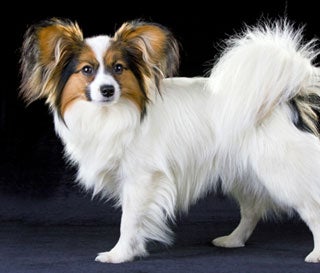Learn about dog breeds
Detailed information & photos on over 190 different breeds
Description
The Papillon is a small dog with a silky, flowing coat, large flared ears that look like butterfly wings, a long, plumed tail, and is quite dainty in appearance. He has a fine bone structure and has a long body for his height. The dog's ears can sit up on his head, or be drooped. They have a close relative called the American Papillon or Phalenes. In the United States this breed is considered part of the Papillon breed, but in France and Sweden they are considered a separate breed.
Coat Description
The Papillon has fluffy looking butterfly like ears that are the easiest way to identify the dog. The Papillon's fur should fall back into place when you run your hand through it. The fur is straight and never curly or wiry. The fur should actually be silky to the touch.
The Papillon can be white with colored patches of almost any color. There is a tri-colored version, a black and white version, a sable version, but never liver colored. The tricolor is black and white on his body, black on his face, and has brown spots above his eyes.
History
The Papillon is related to the toy spaniel, and that breed was thought to have originated in China. Early lines of the toy spaniel were also noted as existing in Spain. Regardless of where the toy spaniel came from, the Papillon himself came from this breed and was raised by nobility in European courts. The first true version of the Papillon was the Phalenes, which later developed the ears of the pricked ears from its original drooped ears, making the Papillon.
Temperament
He is a good show dog and competes well in agility competitions. He is obedient and courageous. They have a lot of spirit and are devoted to their masters. They have a lot of energy and are not considered lap dogs for this reason. The Papillon likes to stalk and chase bugs, butterflies and moths. He can chase small animals like mice, but his small size makes him not usable as a hunting dog. Well trained Papillons will be calm and curious, but poorly trained individuals can bite from fear and can be anti-social. It is important to socialize the dog from the time it is a small puppy.
Health Problems
Like other purebred small dogs, the Papillon has a few health concerns like progressive retinal atrophy, patellar luxation, and other eye and joint problems.
Grooming
When you are bathing your Papillon, it is very important o use the correct shampoo. Papillons with tri-colored, black, white and sable coats need to use a shampoo that is clear, blue, or white. Otherwise the shampoo could eventually turn the coat a yellowish color. Rinse the dog thoroughly or the coat will retain the color of the shampoo. Whitening shampoos can be used successfully on dog with black, tri-colored, or deep sable coats, but never on red coats as the color of the coat will wash out. Cream rinse can be used on Papillons with red or sable coats as their hair is a little drier than the other coat colors. For other colors of Papillon, their hair will look oily is a cream rinse is used. The dog should have its hair blown dry before it is combed. Otherwise the hair will break. Many Papillon owners prefer to have a professional groomer take care of their Papillon's coat.
Exercise
Their energy level is high for such a small breed of dog, so the Papillon needs quite a bit of exercise for a little dog. He needs to be able to use up his energy outdoors so he does not bark incessantly or misbehave while indoors. Of course, this is not to say that the Papillon should be used as a running companion for his owner. The dog is too small to keep up with an adult person for any extended length of time. Plus, he does not have that much energy.
Training
Because he is intelligent, the Papillon is trainable. He is a people pleaser and loyal to his owner and this works well for training purposes. They enjoy competition, work, agility tests, tricks, and anything else that they can use both their minds and their energy. Training must be consistent to work properly with this particular breed. The dogs learn from their surroundings and will sometimes learn bad habits so training needs to begin early in the dog's life. The breed responds best to positive reinforcement training methods. He is an excellent show dog, not only because of his intelligence, but also because of his agility. He performs tricks willingly when well trained and he enjoys training sessions that help him utilize his energy.
Advertise | Privacy Policy | Terms of Use | Contact Us © Copyright 2004-2024 PupCity.com. All rights reserved.
